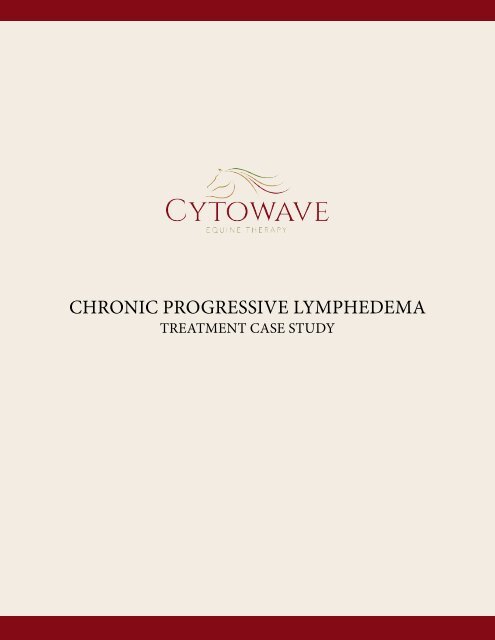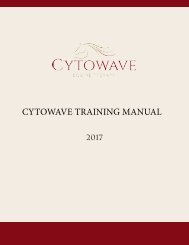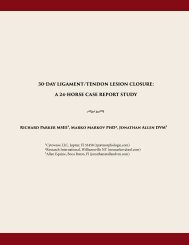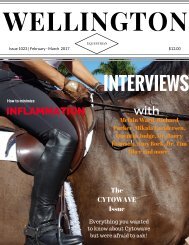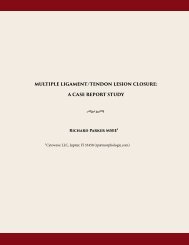CPL JD final with Keegan pictures
Create successful ePaper yourself
Turn your PDF publications into a flip-book with our unique Google optimized e-Paper software.
CHRONIC PROGRESSIVE LYMPHEDEMA<br />
TREATMENT CASE STUDY
◊◊<br />
CYTOWAVE EQUINE THERAPY PROPOSAL<br />
FOR CHRONIC PROGRESSIVE LYMPHEDEMA<br />
I).<br />
II).<br />
III).<br />
IV).<br />
V).<br />
What is Cytowave Equine Therapy?<br />
<strong>CPL</strong> Treatment Case Study Timel ine<br />
Cytowave Equine Therapy treatments for <strong>CPL</strong><br />
Interview <strong>with</strong> Emily Jewell<br />
Cytowave Equine Equipment for <strong>CPL</strong><br />
VI). Cytowave Equipment Purchase Price<br />
VII). Cytowave Rent to Own Program
Special Feature • Cytowave<br />
Cytowave – A new medical therapy technology<br />
Reliably reduces recovery times from serious tendon and ligament injuries by 5 months<br />
By Richard Parker, Chief Technical Officer, CytoWave<br />
Cytowave is a patented,<br />
non-invasive treatment based<br />
on tissue specific signals.<br />
While other devices in the<br />
equine market use generic<br />
electromagnetic waveforms,<br />
Cytowave offers a tissue<br />
specific analytic method<br />
based on the biology of<br />
the injury. The tissue signal<br />
is derived based upon the<br />
difference in biomagnetic<br />
signals from normal and<br />
injured tissues. This<br />
proprietary SQUID Therapy<br />
Signal (STS) is amplified and<br />
delivered via a mild magnetic<br />
field. This new technology<br />
has been embraced by many<br />
top veterinarians and is being<br />
used as an adjunct to stem<br />
cell therapy or PRP.<br />
The Basics of CytoWave Technology<br />
Equine tendon and ligament injuries occur frequently in both competitive and companion<br />
animals. Unfortunately, this type of trauma does not lend itself to fast, non-invasive recovery<br />
techniques. Disorders of these tendons often become chronic and are difficult to manage<br />
successfully. In most cases, recovery is prolonged for many months and even years.<br />
It is theorized that the mechanism for accelerating the closure of ligament and tendon lesions<br />
is found in the nature of the electromagnetic signals impressed on the subject. The specific<br />
and complex activity known as the “healing process” is an expression of the local activity of<br />
electromagnetic fields, as their generation is spontaneous and inevitable due to ionic and<br />
charged particle flow.<br />
CytoWave Therapy technology takes<br />
an actual electromagnetic signal<br />
given off by the body at an injury site,<br />
stores and then amplifies that signal<br />
before re-admitting to the subject so<br />
as to accelerate the healing process.<br />
This “jump-start” occurs because<br />
the signal applied to the injury is very<br />
similar to the same signal the horse<br />
produces. That signal, therefore, is<br />
readily accepted on a cellular level<br />
and processed in such a manner as<br />
to accelerate the recovery.<br />
Opposing coils held by a boot apparatus deliver<br />
the CytoWave STSTM signal<br />
Thus, we have a targeted, tissue specific physical therapy which can be used for soft (muscle<br />
and nerve), dense (tendons and ligaments) and hard (bone splinters or hairline fractures) tissue<br />
injuries.<br />
Cytowave derived signals contrasted <strong>with</strong> the much older PEMF technology.<br />
“We’ve used Cytowave<br />
most effectively for<br />
tendon injuries, some<br />
suspensory branch<br />
injuries, it’s been very<br />
helpful.”<br />
— Dr. Tim Ober,<br />
United States Equestrian Team<br />
Simple older PEMF signals<br />
very common in the industry<br />
Actual physiological waveform<br />
which looks nothing like PEMF<br />
Cytowave signals from actual<br />
measurements accelerating repair<br />
These signals have been reported to operate about four times faster than PEMF systems and<br />
obtain consistent results in the 90% range; instead of the 60% range such as is the case <strong>with</strong><br />
other popular technologies. As Cytowave uses tissue-specific signals, it is able to achieve<br />
consistent results unlike other technologies which treat every injury the same. In fact, we very<br />
rarely have a failure to close a serious lesion, reduce deep tissue inflammation, relieve sore<br />
back discomfort or accelerate bone fracture repair.<br />
http://bit.ly/EQS2015Summer<br />
16 | Henry Schein Animal Health ph: (855) HSAH-EQ1 (472-4371) | fx: (888) 329-3861 | www.henryscheinvet.com
◊◊<br />
Below are a set of images from two severe injuries. The first set of<br />
images show a fracture of the C4 vertebrae in a horse that slipped<br />
on ice. The first scan, taken at the time of the injury shows the<br />
severity of the fracture. The second image was taken after 8 weeks<br />
of treatment using the Cytowave fracture program.<br />
We have found that the Normalizing Signal Waveform (the<br />
mathematical difference between the injury waveform and healthy<br />
waveform) contains information about therapeutic recovery<br />
representing the biological activity of the body in affecting the<br />
injury repair. This signal can be applied using an external complex<br />
signal generator which contains the recorded waveform patterns,<br />
connected to a coil applicator delivery system, as shown in the<br />
process diagram of patent 7,361,136 (2):<br />
Figure 1 – Development of the STS signal<br />
The second set of images below is from a 24 year old horse that<br />
suffered a lesion covering 75% of a tendon. Typically, Cytowave<br />
can close a serious lesion in 3 to 5 weeks in a young, healthy horse<br />
but given the advanced age of the subject, the healing process<br />
was much longer. The horse has begun rehabilitation after 13<br />
weeks of treatment that closed the lesion and substantially reduced<br />
inflammation.<br />
This patented technology is now being routinely implemented by<br />
CytoWave LLC (3, 4, 5, 6,) in a series of studies and production<br />
installations for equine applications in preparation for an FDA filing.<br />
This technique described as SQUID Signal Therapy (STSTM) has<br />
the effect of rapidly accelerating the closure of ligament and tendon<br />
lesions from a typical 6-12 months healing time to a nominal 3-5<br />
weeks (4).<br />
Both cases represent severe and difficult to heal injuries but the<br />
images clearly illustrate that Cytowave technology, utilizing Squid<br />
Therapy Signals , can effectively influence normal and injury<br />
currents, thus contributing to, and accelerating the healing.<br />
STS (Squid Therapy Signal)<br />
The development of the SQUID (Superconducting QUantum<br />
Interference Device) makes it possible to discover natural magnetic<br />
field waveforms as a further extension of magnetic field therapy<br />
technology. As the waveform is theorized to contain the intelligence<br />
of the biological functions taking place locally, it is also proposed<br />
that detection and generation of the proper waveform associated<br />
<strong>with</strong> a given healing process would be an essential component of an<br />
optimal waveform delivery device designed to accelerate the healing<br />
process by delivering that same waveform, in an amplified form.<br />
This proposition was addressed in the paper of Parker and Markov<br />
SQUID-Based Electromagnetic Fields – a Plausible Tool for<br />
Treatment of Tendon Injuries (1). This paper included procedures in<br />
identifying, extracting and isolating characteristics of magnetic fields<br />
emanating from both healthy and injured or diseased portions of the<br />
body. The goal is to discover the pattern revealed in signals which<br />
are expressed by the ”healing component”, and then delivering<br />
those same magnetic field patterns which have a therapeutic effect,<br />
as described in the patent “Method and Apparatus for Generating a<br />
Therapeutic Magnetic Field”, 7,361,136 (2).<br />
NOTE: this material extracted from the paper “The Treatment of Tendon Injury <strong>with</strong><br />
Electromagnetic Fields Evidenced by Advanced Ultrasound Image Processing”, Richard<br />
Parker, Marko Markov, 2014 obtained through CytoWave LLC<br />
References<br />
1. Parker R., and M. Markov, (2014) SQUID-Based Electromagnetic Fields – A Plausible Tool<br />
for Treatment of Tendon Injuries at the Karolinska Institut, Department of Molecular Medicine<br />
and Surgery Stockholm, Sweden, May 2014<br />
2. Parker R.F. (2008) Patent #7,361,136, “Method and Apparatus for Generating a<br />
Therapeutic Magnetic Field”.<br />
3. Parker R., M. Markov, and J. Allen (in press) 30-Day Ligament/Tendon Lesion Closure: A<br />
24-Horse Case Report Study. submitted to the American Association of Equine Practitioners<br />
(AAEP) for the Salt Lake City Conference, December 2014.<br />
4. Parker R. and M. Markov (2015) Electromagnetic Fields in Treatment of Tendon Injury<br />
in Human And Veterinary Medicine. in Markov M (ed) Biological Effects of Electromagnetic<br />
Fields, CRC Press, Boca Raton FL 435-454<br />
5. Markov M. and R. Parker (2012) Electromagnetic Fields in Sports Injuries. Karolinska<br />
Conference on Sports Medicine, Stockholm.<br />
6. Markov M. and R. Parker (2012) Analytical Versus Empirical Design of EMF devices.<br />
BEMS Annual meeting, Halifax, June 16-19, 2012<br />
Cytowave’s technology was granted protection from the US patent office. This technology<br />
was presented at various international meetings such as Scandinavian Congress of Sports<br />
Medicine, VI International Workshop on Biological Effects of Electromagnetic Fields, XXXIIIth<br />
Annual meeting of BEMS and published in peer-reviewed scientific journals.<br />
Call us today at (844) 298-9283 or visit us at<br />
www.cytowave.com to learn more about our programs.<br />
About the Author Chief Technical Officer Richard Parker<br />
has over 35 years of business experience and has been awarded<br />
the central patent on the CytoWave process. Richard is a former<br />
computer microprocessor designer and has also sponsored his own<br />
successful companies in real estate development, and in the energy<br />
field. Richard has focused his attention on the field of biomagnetic<br />
therapy for the past 20 years, where he is a frequently invited speaker<br />
at international venues and has published 14 papers in refereed<br />
scientific journals. Richard earned a B.S. in Electrical Engineering<br />
from the University of Florida and an M.S. in Electrical Engineering<br />
from the Georgia Institute of Technology.<br />
Summer 2015 | eqs | 17
Chronic Progressive Lymphedema<br />
Treatment Case Study TIME LINE<br />
On April, 27th 2016, Cytowave treatments were started on a Friesian stallion for Chronic Progressive Lymphedema<br />
(<strong>CPL</strong>). The following therapy report represents the first ninety (90) day case study period.<br />
All documentation was reported by Emily Jewell, owner of <strong>Keegan</strong> and Grace & Beauty Farms, and John Dovenmuehle,<br />
Cytowave Equine Therapy representative. Photographs taken by Emily Jewell.<br />
HISTORY OF SUBJECT:<br />
Horse: <strong>Keegan</strong>, Friesian stallion<br />
Age: 13 years old<br />
Height: 16.3 hands<br />
Weight: 1400 Lbs.<br />
Owners: Emily and Mike Jewell<br />
Grace and Beauty Farms<br />
Carlisle, IN.<br />
Environmental Conditions:<br />
<strong>Keegan</strong> kept in dry stall area. Stall is exceptionally neat and cleaned every day.<br />
Treatments are in the Farrier area of barn <strong>with</strong> <strong>Keegan</strong> standing on rubber pads.<br />
Exercise: Daily exercise in round pen. Clean dry area.<br />
Emily has owned <strong>Keegan</strong> since his birth and has trained him for show events and movies. He is considered a<br />
member of her family, which of course he is. Emily first noticed signs of <strong>CPL</strong> when <strong>Keegan</strong> was around 5-6 years<br />
old. Small nodules had appeared on <strong>Keegan</strong>’s rear legs, behind the hoofs. The symptoms spread from the right<br />
rear leg to the left rear leg, then progressed to the two front legs.<br />
The right rear leg has three (3) larger nodules and a large fold under the nodules. The left rear leg has two (2)<br />
larger nodules and a smaller fold under the nodules.<br />
The two front legs have small lesions <strong>with</strong> small nodules on both legs. The front legs are not in the trial program<br />
but we are observing them to see if there are improvements <strong>with</strong>out treatment.<br />
OBJECTIVE:<br />
We determined that <strong>Keegan</strong> was in the second stages of the disease. Our first objective was to reduce inflammation<br />
by increasing circulation and lymphatic flow. We also wanted to relieve any soreness and pain in the rear<br />
legs and to make <strong>Keegan</strong> comfortable and give his body a chance to begin healing naturally.<br />
Currently Cytowave therapy does not have a pre-set program for <strong>CPL</strong> so we determined the best program would<br />
be aimed at controlling <strong>CPL</strong> by reducing inflammation. Treatments for this objective are to run continuously<br />
for two (2) weeks. We discussed the results of the treatments daily and based off of our results, set up the next<br />
treatments.
◊◊<br />
TREATMENTS:<br />
We started Cytowave Inflammation/Maintenance treatments on <strong>Keegan</strong>’s rear legs where the <strong>CPL</strong> was most<br />
severe. The Inflammation/ Maintenance treatment is a thirty minute noninvasive treatment. We treated the rear<br />
legs, using a dual application <strong>with</strong> foreleg therapy boots. The boots were placed on top of the coronary band<br />
<strong>with</strong> coils on the side of the legs. The therapy boots, coils and Cytowave equipment were applied and administered<br />
by Emily.<br />
RESULTS:<br />
DAYS 1-7<br />
▶ A noted decrease in inflammation / swelling in the rear legs was observed after four (4) days of treatments.<br />
▶ Circulation and lymph flow appeared to have increased and there was a marked decrease in the size of the<br />
cannon bone.<br />
▶ The nodules and folds are softer, and more pliable, not as hard to touch. There is a little dampness and oily<br />
feeling in the back of the hoof.<br />
▶ The therapy boots are easier to apply, due to the swelling in the legs subsiding.<br />
At the end of first week of treatments, <strong>Keegan</strong> was more relaxed and visibly comfortable. He is more active when<br />
Emily turns him out in the pen to exercise and <strong>Keegan</strong>, has started to canter for the first time in 4 years.<br />
Note the shaved area on the hoof on the image to the left. This is where the canon bone was measured daily. The<br />
other two images show the nodule formation and the swollen cannon bone area.
These images show the affected areas - note the shaved areas to the right that show the reduction in the folds<br />
DAYS 7-21<br />
Cytowave treatments used: Tendon / Ligament treatment program.<br />
▶ The continued reduction in inflammation and swelling indicates lymphatic vessels are opening.<br />
▶ Cannon bone swelling also continues to reduce in size.<br />
▶ Folds in the rear of the legs are not has thick and are separating. Folds and nodules are softer and more pliable.<br />
▶ Still some dampness and oily feeling in the crease of the back of the hoof area. Lesions continue to heal and are<br />
drier and smaller.<br />
▶ <strong>Keegan</strong>’s rear legs are not as sensitive in the area of the nodules. Emily is able to massage his legs <strong>with</strong>out any<br />
discomfort.<br />
▶ <strong>Keegan</strong> is noticeably feeling better. He is more active, and runs and bucks in the open pen area.<br />
This series of images show the shrunken nodules and folds on <strong>Keegan</strong>’s legs.
◊◊<br />
DAYS 22-36<br />
Changed Cytowave treatment program to Buck Shins. Lesions on rear legs continue to heal<br />
▶ Swelling and inflammation continue to reduce in size and lymphatic vessels have opened. The cannon bone<br />
measures at 10 ½” down from 12 ½”.<br />
▶ <strong>Keegan</strong> is running in the arena after treatments and for the first time in four years he is cantering.<br />
DAYS 37-51<br />
Cytowave treatment program changed to bone fracture.<br />
▶ Reduction in swelling continues which we believe is due to decreasing inflammatory response of the lymphatic<br />
vessel.<br />
▶ Folds are decreasing in size and feel softer and more pliable. Nodules are smaller. Emily massages <strong>Keegan</strong>’s<br />
pastern areas which also helps increase the Lymphatic flow and circulation.<br />
▶ Dampness and oily feeling decreases. The area under the feathers feels drier.<br />
▶ <strong>Keegan</strong> continues to be more active, running and jumping in the lunging arena.<br />
DAYS 52-66<br />
Continuing <strong>with</strong> Bone Fracture treatment based on Keenan’s continued progress.<br />
▶ Nodules and folds continue to decrease in size.<br />
▶ Emily continues to manually massage rear legs and continues to exercise <strong>Keegan</strong> after treatments, which helps<br />
keep the lymphatic vessels and circulation flowing.<br />
DAYS 67-81<br />
Emily continued Cytowave Bone Fracture treatments. Due to a heavy summer schedule, the treatments were<br />
limited to three (3) per week. Of note, <strong>Keegan</strong>’s condition stayed the same even after reducing the number of treatments.<br />
Swelling and inflammation did not increase, which indicates the quality of healing is substantial.<br />
DAYS 81- 95<br />
Based on Keenan’s condition, the three (3) treatments per week are continued.<br />
▶ There is no increase <strong>with</strong> inflammation and swelling or in the size of the nodules and folds during this period.<br />
▶ Rear legs and cannon bone size remains the same.<br />
Note: <strong>Keegan</strong> is in the Breyer Fest Show in Kentucky and his trainer mentions that <strong>Keegan</strong>’s control is better than<br />
it has been in many years and there is a significant difference in <strong>Keegan</strong>’s performance.<br />
95 DAYS<br />
Emily has started treating <strong>Keegan</strong> <strong>with</strong> Cytowave Bone Fracture treatments every day and he continues to enjoy<br />
his treatments and his energy level is high.<br />
▶ To date, <strong>Keegan</strong> has not relapsed as his treatments continue.<br />
▶ There is no further inflammation, or swelling on <strong>Keegan</strong>’s legs.
VETERINARIAN EVALUATION<br />
Dr. Royal visits periodically during treatment sessions. He notes that the swelling and inflammation has drastically<br />
reduced. <strong>Keegan</strong> is in very good health.<br />
▶ <strong>Keegan</strong>’s HR = 36, RR=18 and Weight is 1400#<br />
▶ His BAR, (Bright, Alert, Responsive), is excellent.<br />
▶ He is sound <strong>with</strong> little sensitivity in the folds of his legs.<br />
“Nodule’s are shrinking because of better Lymph flow. Inflammatory response up the leg is getting better because of<br />
decreasing inflammatory response of the lymphatic vessel...From a clinical standpoint, the Cytowave treatment’s are<br />
significant.”<br />
Dr. Royal<br />
Royal Veterinary Service<br />
Odon, IN.
◊◊<br />
CYTOWAVE EQUINE THERAPY<br />
TREATMENTS FOR <strong>CPL</strong><br />
This is the first documented case of <strong>CPL</strong> being treated <strong>with</strong> Cytowave therapy. These are our recommendations<br />
based on the outcome of this case study in which Cytowave seems to have stopped the progression of the <strong>CPL</strong><br />
and resulted in reversing the condition. To date, the subject has not relapsed and his Cytowave treatments<br />
continue.<br />
There are three (3) different Cytowave treatment programs that were used to control the progression of <strong>CPL</strong> in<br />
<strong>Keegan</strong>:<br />
1) Inflammation<br />
2) Tendon / Ligament<br />
3) Bone Fracture<br />
As <strong>with</strong> any injury, the inflammation treatment program should always be used first. One of the strengths of<br />
Cytowave therapy is the ability to quickly reduce pain and inflammation. Results are more noticeable <strong>with</strong> an<br />
“edema” based disease such as <strong>CPL</strong>. Starting <strong>with</strong> the 30 minute inflammation also allows a horse to get used to<br />
wearing the treatment applicators and gives the owner a chance to observe how the horse responds to the<br />
treatments.<br />
With stage 1 <strong>CPL</strong>, the Tendon / Ligament treatments can be used after starting <strong>with</strong> the Inflammation treatment<br />
program. The Cytowave Tendon/Ligament treatment programs can have a very positive effect on reducing<br />
soreness, pain and swelling.<br />
For stage 2 & 3, it is recommended to follow the same process as you would <strong>with</strong> stage 1 <strong>CPL</strong>. Start <strong>with</strong> the<br />
inflammation treatment for 2 - 3 days, then to the Tendon/Ligament program for approximately one week. If<br />
there are continued signs of healing, you can progress to the Bone Fracture treatment program. The Bone<br />
Fracture treatment program is recommended for use when nodules and folds are present in the legs.<br />
As <strong>with</strong> all Cytowave treatment programs, your horse will tell you if the program is having a positive outcome.<br />
If you use the Tendon/Ligament program for several days and notice that the healing progress has plateaued,<br />
return to using the inflammation program.<br />
The inflammation program appears to help control <strong>CPL</strong>. The number of maintenance treatments needed depend<br />
on the condition of the <strong>CPL</strong> and how the horse responds to the treatments. It is safe to use the inflammation (30<br />
minutes) up to three times a day.<br />
Before the start of any Cytowave treatment programs, it is recommended you consult your veterinarian. The<br />
Cytowave Representatives will also consult <strong>with</strong> your veterinarian and explain the Cytowave technology,<br />
treatments and results that we are trying to achieve. The Cytowave Corporate office staff are available to assist<br />
<strong>with</strong> any questions regarding the treatments as well.
AN INTERVIEW WITH EMILY JEWELL<br />
Emily and Mike Jewell own a small farm in southern Indiana and they breed and raise Friesian and Andalusian<br />
horses. At any given time they care for 10 or more horses, a few of which are Friesian and Andalusian mares.<br />
They stand two stallions, an Andalusian and their pride and joy Friesian stallion <strong>Keegan</strong>. <strong>Keegan</strong> is the celebrity<br />
in their area and has appeared in several magazines such as Horse Illustrated and Horse and Rider. <strong>Keegan</strong> and<br />
some of their other horses have been used in several Farnam ads. <strong>Keegan</strong> has really made a name for himself and<br />
Grace and Beauty farms <strong>with</strong> all of his accomplishments.<br />
Emily understands that when it comes to horses, there is no shortage of maladies that they can suffer from. For<br />
example, Emily noticed something was wrong <strong>with</strong> one of her Freisians when they were around 5 or 6 years old.<br />
Small nodules had appeared on the horse’s rear legs, just behind the hoofs. At first Emily thought the horse<br />
had scratches, but when the condition worsened, she researched and discovered that this was the early stage of<br />
Chronic Progressive Lymphedema (<strong>CPL</strong>), a lymphatic disorder that many draft horses, including Friesians are<br />
predisposed to.<br />
Emily began treating her Friesian horse to slow the advancement of <strong>CPL</strong> but results were not positive. In spite of<br />
her efforts, the symptoms spread from the right rear leg to the left rear leg, then progressed to the two front legs.<br />
She began to fear the inevitable - since there is no known cure, most heavy bodied horses <strong>with</strong> <strong>CPL</strong> have to be<br />
euthanized around 15 years old.<br />
By chance, Emily was approached at a horse show by John Dovenmuehle who told her about Cytowave. “When<br />
he said “inflammation reduction” I really perked up,” Emily said.<br />
At this point, she was ready to try anything to slow down the progress of this relentless, inflammation based disease.<br />
Cytowave did not have a specific <strong>CPL</strong> based set of therapy signals, but it did have a robust pain/inflammation<br />
program that had proven effective <strong>with</strong> other inflammation based conditions, including cellulitis. “At first,<br />
I didn’t know what to think. We had tried everything up to this point but really didn’t have anything to lose.”<br />
Emily stated.<br />
On April 27th, 2016, Emily began to use Cytowave treatments exclusively on her horse. After only 4 days of<br />
treatments, Emily noticed the inflammation had decreased. After the first week, the inflammation in the rear legs<br />
and the Cannon bone size had decreased as well. The nodules and the folds were softer, not as hard to the touch<br />
and the Cytowave boots were easier to wrap around his legs<br />
due to the decreased swelling.<br />
The shift in her horse’s demeanor underscored that positive<br />
physical changes were taking place. “He was more relaxed and<br />
comfortable. When I let him out in the pen, he was more active,<br />
running and bucking,” Emily said.<br />
After eight (8) days, the inflammation and Canon bone swelling<br />
continued to decrease. The folds in the rear legs were not<br />
as thick and were separating. Folds and nodules were softer and<br />
more pliable. There was still some dampness and oily feeling in<br />
the creases of the back hoof area but overall, the lesions were<br />
drier and reducing in size. And for the first time in weeks she<br />
was able to massage his legs <strong>with</strong>out any discomfort.
◊◊<br />
“He really began enjoying getting his legs massaged after his treatments,” Emily continued. “Overall he just seems<br />
really happy. I did not realize how much the disease had slowly robbed him of his spirit over the years because it<br />
was so gradual. Once he started feeling better, I realized I was getting my old horse back!”<br />
In the span of 10 days, measurements showed that the swelling had been substantially reduced. The Canon bone<br />
showed the most dramatic reduction in size, <strong>with</strong> the left leg going from 12 ½” to 10 ½”.<br />
On May 11th, Dr. Royal evaluated her horse and he noted that the Cytowave treatments had drastically reduced<br />
the swelling and inflammation. He said her horse seemed to be in very good health and his BAR (Bright, Alert,<br />
Responsive) was excellent. He was in very good health, sound, <strong>with</strong> little sensitivity in the folds of his legs.<br />
After twenty one (21) days of treatments, Emily continued to see positive results in slowing the progression of<br />
the <strong>CPL</strong> condition. The size of the folds and nodules decreased and lesions in the rear legs were drier and smaller.<br />
Pain and sensitivity in the folds of his legs lessened. His overall health improved and it was apparent that her<br />
horse felt much better.<br />
“At first he stamped his feet and was a bit agitated until he got used to the boots,” Emily said. “Now it’s a walk in<br />
the park for him and he really enjoys the treatments.”<br />
Her horse will continue <strong>with</strong> treatments and hopefully completely recover. As for Emily? She was so impressed<br />
<strong>with</strong> the results that she is now working for Cytowave to help promote their new technology.<br />
CONTACT INFORMATION:<br />
Emily Jewell - Grace and Beauty Farms<br />
Carlisle IN<br />
812-691-1839
EQUIPMENT COST FOR <strong>CPL</strong><br />
Controller/ Computer - $4,500.00 (Refurbished)<br />
➢With three programs, and one maintenance/inflammation program<br />
➢Includes, 25’ extension cable, 12’ break away cable and test magnet<br />
➢Included treatment program (Maintenance/Inflammation) and client picks an<br />
➢additional 2 treatments: choice of –<br />
Fracture<br />
Ligament/Tendon<br />
Bucked Shins<br />
Hock/Knee/Joint<br />
Complete Leg Applicator Kit- $675.00 (value of $710.00)<br />
➢Includes one therapy boot, oblong coils (set), belt pockets (set)<br />
➢two belts and two snaps<br />
Additional-$650.00 (value of $710.00)<br />
➢One therapy boot, oblong coils (set), boot pockets (set), two belts and two snaps.<br />
➢One 20” “Y” connector (value of $80.00)<br />
Warranty<br />
➢3 years, on Controller/Computer<br />
➢1 year, on Coils<br />
➢3 months, Applicators<br />
Replacement/Repair<br />
➢Advance Replacement/Repair of all, applicators and accessories<br />
➢Optional, loaner available for advanced replacement of controller/computer. No<br />
➢Charge if determined purchased controller/computer os covered by warranty.<br />
Insurance<br />
➢$1800.00/ one year, (equivalent to $150.00/month), can only purchase at onset of<br />
Agreement.<br />
➢Must be paid in full, <strong>with</strong> payment of purchased agreement<br />
All Cytowave products are made in the USA. All products are assembled for each order individual order.
◊◊<br />
<strong>CPL</strong> - RENT TO OWN PROGRAM<br />
1. $550.00 paid monthly<br />
2. $550.00 deposit one-time payment<br />
3. After 6 months client can either return items or all monies can be applied to purchase<br />
including deposit. If client decided to keep unit longer than 6 months at 9 months 75% of<br />
rental monies can be applied towards purchase. At 1yr client can apply 50% of rental money<br />
towards purchase, or property must be returned to company<br />
4. $5,525.00 total purchase price, excluding tax.<br />
Rent to Own Program provides the following Cytowave Equipment:<br />
➢Controller/ Computer - (Refurbished)<br />
➢With two programs, and maintenance/inflammation program<br />
➢Includes, 25’ extension cable, 12’ break away cable and test magnet<br />
➢Ligament/Tendon program<br />
➢Bone Fracture program<br />
➢Retail purchase price is over, $13,500.00<br />
Complete Leg Applicator Kit-<br />
➢Includes one therapy boot, oblong coils (set), belt pockets (set)<br />
➢two belts and two snaps.<br />
Retail purchase price is, $710.00<br />
Additional Cytowave equipment, add $40.00/ month<br />
➢One therapy boot, oblong coils (set), boot pockets (set), two belts and<br />
two snaps.<br />
➢One 20”, “Y” connector<br />
Regular retail price is, $795.00
CYTOWAVE EQUIPMENT FOR <strong>CPL</strong><br />
Cytowave Equine therapy equipment includes:<br />
➢Controller/Computer-<br />
➢Pre set programs for <strong>CPL</strong> treatments<br />
Inflammation<br />
Tendon/Ligament<br />
Fracture Bone<br />
➢25’ Extension cable, 12’ breakaway cable<br />
➢Foreleg therapy boots (2)<br />
➢Foreleg Therapy Boot Pockets<br />
➢Leg coil Belts (4), used for stabilization<br />
➢Boot snaps- (4) extra, attaches to coil pockets<br />
➢Oblong Coils (2) sets, fits Foreleg Boot Pockets<br />
➢20” “Y” cable<br />
➢Test Magnet


